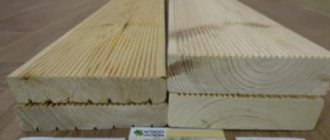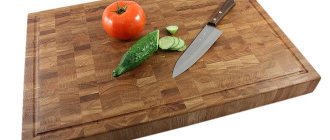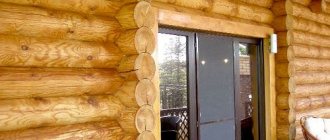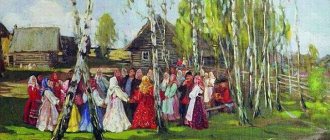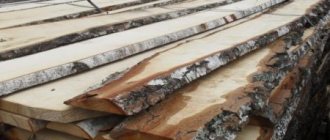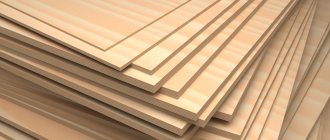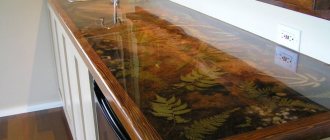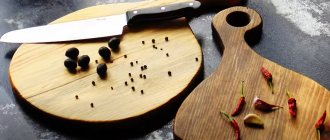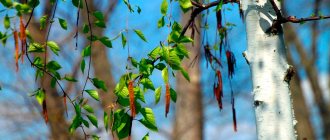Wood is a valuable and beautiful natural material. But the wood of burl and suvel surpasses ordinary wood in the beauty of its natural pattern. Burls and suvel... Burls and suvel are growths on trees, which arborists call defects of the tree trunk.
But in the hands of masters, “vices” like burl and souvel turn into magnificent works of art.
Wood burl (left) and suvel (right)
What is wood burl
The burl is formed in the form of a growth on the trunk, usually round in shape, covered with bark. Sometimes the growth completely rings the trunk. The growth is formed by dormant, adventitious buds. The buds are shaped like tubercles with a ring structure around them. Sometimes dormant buds “wake up”, then young shoots may appear from the growth.
The appearance of burls is observed mainly on deciduous trees, although such growths can be found on coniferous trees. Of the wood species common in Russia, burls most often appear on the trunks of linden, oak, aspen, maple, birch, and elm.
The cap takes a very long time to grow. We are talking about tens of years. Its dimensions can be from a couple of centimeters to a meter, or even two. There may be two or more burls on one trunk.
There are two types of burl - basal and stem, formed, respectively, at the root or higher on the trunk.
Why does a growth called a burl appear?
There are three options for the origin of the burl. But they are all not 100%
First option
- An adventitious bud grows under the bark, but the bark, due to its high strength, does not allow the bud to develop. Since the “forces” have already been abandoned, nutrients and plant hormones rush to the site of bud growth. So, one by one, adventitious buds try to break through the bark, forming the growth of the burl.
Second option
- The accessory bud under the bark cannot develop normally due to mechanical damage, such as the human hand, hurricanes, animals, and so on. Therefore, it continues to grow with deformed development.
Third option
- After the adventitious bud appears, the tree feeds the burl due to bacteria, fungi, insects, viruses, and early spring frosts.
The nature of the mouth guard is not 100% determined. But we are more interested in the texture of the burl than in its origin.
Amazing phenomenon
When cutting a birch tree correctly, you can see amazing phenomena. To be more precise, the interweaving of wood fibers forms pearlescent areas with a unique pattern. They begin to emit a special glow when reflected from sunlight. The effect looks very beautiful in finished products, for example, in a stacked handle made of birch suvel.
The pattern and color are distinguished by their uniqueness; as a rule, it is brownish-ocher, soft pink, straw with a pearlescent sheen, and less often - dark brown with a marsh tint.
Burl texture
- The fabulous natural pattern of burl wood consists of:
- Twisted annual layers, usually pronounced
- Pronounced core of small branches
- Curly complex structure
Maple burl
Each burl, like a human fingerprint, has an exclusive pattern and shape. No, in nature there are no two identical growths, called burls. Moreover, neither in the shape of the growth, nor in its structure.
Immediately after cutting the burl, its rich texture is practically invisible. Burl wood reveals its texture to its fullest extent after sanding, polishing and toning.
Birch burl product
- Stem burls have a more refined texture than root burls.
- Processing burls is difficult due to the large presence of knots and twists.
- The burl, after processing, looks like marble or malachite and has a pearlescent sheen.
The color of burl wood can be brown, milky, pinkish, greenish, depending on the type of tree and where it grows.
"Steaming" method
It is important that it is necessary to cut down the growth only during the dry season, throughout the year (this is the period from late August to early September).
- The growth needs to be cut down. The process is performed with a sharp saw. The object resembles a stone, it will take a long time to saw. There is no need to peel off the bark. After this work, do not forget to lubricate the wood with paint to stop the flow of juice.
- The second step will be to find a container for boiling. It is advisable to select an unnecessary pan. After all, during the process, different consistencies and resins are released, due to which you will have to throw away the dishes. Next, you throw the mined specimens there. You need to pour enough water to cover everything by two centimeters (2 cm). As the liquid boils and evaporates, add liquid a little at a time.
- The third part will be extracting and adding layers to our soup. The task will be to bring it to triper salinity. This is necessary for this. to remove all available moisture from the item being processed. If you live by the sea, pour in sea water. It will be faster this way.
- To reveal the structure, give strength, and a good smell, you need to add pine or spruce shavings to the container. They contain resins that the processed parts do not have. In addition, we will give the color ocher-brown, pink-yellow.
- In the process, the water will evaporate. Add to liquids as needed. It is added exactly enough until a little more than it boils away. As a result, we get a reddish broth. Drain the broth, as it will be impossible to wash it.
I have tried to briefly describe the main part of the boiling, the important factors of which were the presence of salt and resin. See the photo below.
Below I will publish the drying process at a fast pace. It is not difficult, but it requires attention. The result exceeds all expectations...
What is wood suvel
Suvel is a round growth on a tree trunk, covered with bark. The build-up consists of deformed and twisted wood fibers.
Typically, wood suvel is formed in a single form, less often as a group of suvel on one tree trunk. Sometimes there are suvels encircling a tree trunk
Unlike burl, suvel forms equally on deciduous and coniferous trees. The density of suvel wood is lower than that of burl, so it is a little easier to process.
A quick way to dry wood
After we have steamed over the fire for about six to eight hours (6-8 hours), it is necessary to pay attention to some nuances.
- Now we need to take out a piece of wood from everything, or if there are a lot of them, pieces of wood and put it there to dry. Throw away the water if it is no longer needed.
- If everything becomes dry, boil again in the same spirit, but for four to six hours (4-6 hours). I recommend using a pressure cooker. It will be much faster this way.
- Wearing gloves, you need to peel off the bark unless it falls off, which is most likely.
- At this stage we are done with cooking, now we need to take it out and put it somewhere. It will dry out within one or at most two weeks. In terms of callousness and strength, it is not inferior to either bone or stone, and the smell will make it clear that this is wood.
- During this period, cracks may appear. They need to be cleaned and removed by treatment as they arise.
- After all the simple work, you can start making a product, such as a handle.
We hope that the above recommendation suits everyone. If something doesn’t work out, write to us, we will try to help you with any question.
Why does a growth called suvel appear?
As a result of external influence on the tree, a fold is formed. Over time, the fold becomes overgrown with tortuous fibers. This is suvel.
There are more suvels on the trees than burls. Under the bark, tree suvels have a smooth surface, and not “pimples”, like burls.
Suveli can have different textures; the predominant shapes include waves, curves, spots, and stripes. After sanding and polishing, the shine and shine of the wood appears.
Suvel ash
Suvel can be of various shades, mainly brown, yellow, gray, slightly greenish, or vice versa with pinkish “notes”
Like mouth guards, suveli can be stem or root. The stem ones are lighter in color and have a less pronounced natural pattern than the root ones.
How to cook correctly?
This method is used by many masters. While cooking the material in one way or another, you can give the wood the desired shade, speed up drying, or reveal the existing pattern. The appearance of the birch suvel product will depend on this.
The process goes like this:
- The blanks, previously cleared of bark, are placed in the pan. Next, pour water so that it covers the wood by 2-3 cm. Then add 2 tbsp. spoons of coarse salt per liter of water and put on fire. In addition, coniferous, birch or alder sawdust is added to the solution. They give the souvel a color from dark amber to golden.
- After the water boils, turn the fire to low and cook the material for 4 hours, if the workpiece is large - 6 hours. Then the liquid is drained and the wood is left to dry. On the second and third days, the process must be repeated. The result should be 12-18 hours of cooking over 3 days.
- Cooking in a saline solution is caused by a simple physical reaction. The tree contains sap, the density of which is lower than the brine solution. During cooking, the liquid penetrates the material and dehydrates it. This occurs by displacing tree sap and absorbing the salt solution. As a result, liquid diffusion occurs and the suvel dries. After cooking, the wood is wrapped in newspaper and packed in a plastic bag. The next day, the paper should be slightly damp; the suvel can be left to dry in natural conditions. If desired, you can dry the material for another day using newspaper.
What is made from burl and suvel
From the “wonderful” growths, in the form of burl and suvel wood, decorative crafts, souvenirs, knife handles, panels, key rings, cufflinks and jewelry, hairpins, bowls, vases, dishes, boxes, canes, lamps, chess, frames, snuff boxes and many other small items. They also produce veneer. Burls and suveli go well with metals, mother-of-pearl, and bone.
Birch burl ladle
Burl pano
Birch burl
birch suvel
Subscribe to our Yandex.Zen channel
Treatment
Processing birch burls with your own hands is a creative and interesting activity for any specialist who is interested in woodworking. Not everyone can dry birch burl at home. To do this, you need to practice on less valuable wood.
It is necessary to take into account that the preparation for deep dishes from suvel or burl is done even before drying. That is, the required recess is cut out and given a pre-designed shape. Then the workpiece is dried, after six months it can be taken out and refined to perfection.

